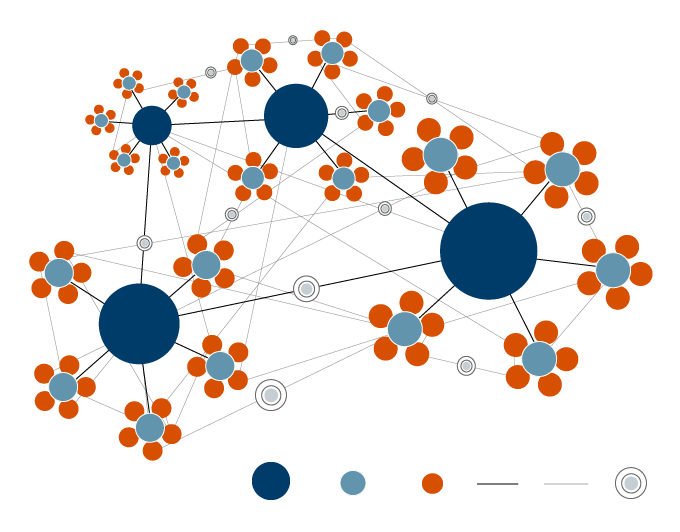July 12, 2018
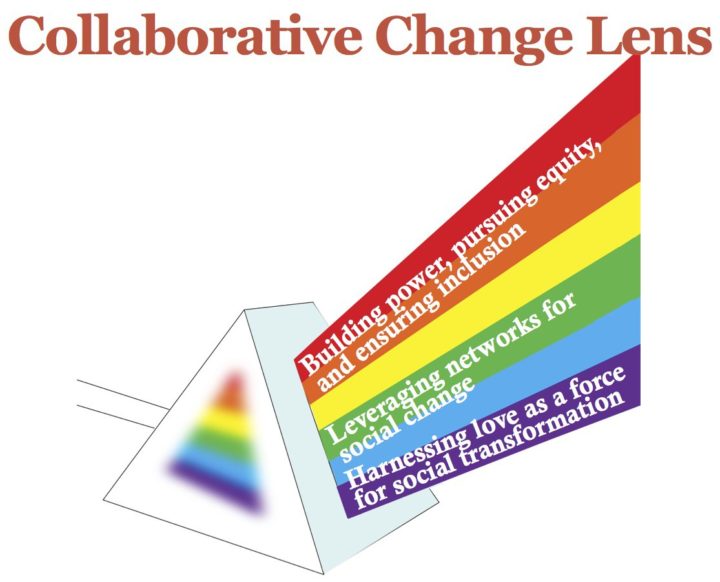
Building on the theme of our recent blog post, Power Dynamics: The Hidden Element to Effective Meetings, we are reposting a series of posts written by our former IISC colleague Linda Guinee. Linda wrote a masters’ thesis on addressing power dynamics in collaborative process design and facilitation. She did this study based on questions raised over the years by another former IISC colleague, Cyndi Suarez (current Senior Editor at NonProfit Quarterly and author of The Power Manual: How to Master Complex Power Dynamics) – and as she put it, “with the belief that if power dynamics are not well understood and addressed, group process facilitators are likely to unknowingly reinforce the status quo – a scary thought for those of us working on social justice and social change!”
As Linda wrote in her opening post in 2010:
“One thing that woke me up at two in the morning – one of those notorious ‘aha’ moments – was that when doing an extensive literature review of group facilitation literature and conflict resolution literature at that time (2005), I found that conflict resolution/engagement literature is packed full of discussions about addressing power dynamics – while group facilitation literature rarely (if ever) talks about power I only found a very small handful of references to power (as in two or three) anywhere in the very extensive group facilitation literature – and only in reference to people with positional power. There is, in fact, an assumption built into group facilitation methodology that collaboration on its own somehow balances power dynamics.”
Here is her second post in the series …
One of the first questions you might ask when thinking about looking at power dynamics in group facilitation is what IS power anyway? This seemingly simple question, of course, is not really all so simple after all. What do you think? How would you describe power?
When I first started trying to answer this question for myself, I found that I was overwhelmed with material – literally hundreds and hundreds of books about what power is, where it comes from, how it operates, etc. For many, a definition of power has to do with the ability to force something to do something they wouldn’t have done otherwise – a coercive definition of power. Feminist psychologist Jean Baker Miller described power as “the capacity to produce a change.” Others (and in fact, our common terminology) talks about power as a “thing” that can be divided, shared, owned, and transferred.
Read More
June 18, 2018
“Words are how we think, stories are how we link.”
– Christina Baldwin
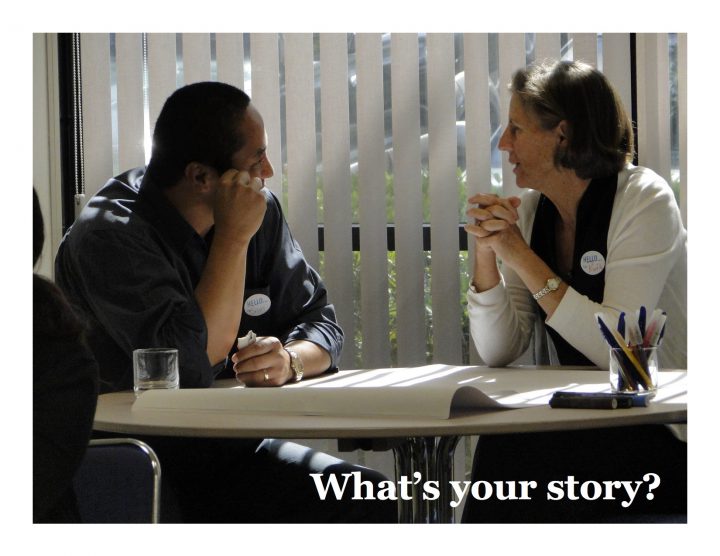
Last week I had the privilege of facilitating a two-day Network Learning Lab for a remarkable group of conservation leaders and network weavers. I co-designed the session with Olivia Millard and Amanda Wrona of The Nature Conservancy (and at the instigation of Lynn Decker of the Fire Adapted Communities Learning Network) to connect and strengthen the capacity of those working at the intersection of ecosystem health and human/community development while building networks at local, state, regional, national and global levels. Our design was informed by input given by the participating network weavers themselves about their core challenges and learning objectives, while leaving room for the unexpected – enough spaciousness for the network magic of emergence to happen.
As with other network leadership institutes that we at IISC have had a hand in designing and facilitating, the experience last week had as its foundation plenty of opportunities for the cohort to authentically connect, to get to know one another on both professional and personal levels. And as with both leadership development sessions and ongoing network development initiatives that we support, we turned to storytelling as a way to create bonds and understanding. This included time for the participants to tell brief stories about their networks, doing so in 5 minute informal bursts sprinkled throughout the two days (which could also have been done as Pecha Kucha or Ignite presentations). The intent was to create a bit more understanding of what might make each network unique in its aspirations, attributes and accomplishments and to whet people’s appetites for further conversation at breaks, meals and into the evening.
“There is no greater agony than bearing an untold story inside you.”
– Maya Angelou
We also set up a couple of exercises within the first hour of the lab for people to hear more about one another’s paths to the work they currently do, not by ticking off their resumes, but by telling stories about what happened to and moved them to be where they are now. Time and again, when I facilitate this kind of exercise, it shifts the tone of the gathering in the direction of greater openness and trust. And as we touched on in our debrief of those exercises, inviting that kind of storytelling into our work can send a signal about what is validated with respect to forms of knowing, expression and parts of ourselves to bring to the table. Along these lines, we also drew from poetry and other forms of creative expression, including a stanza from a favorite William Stafford piece, “A Ritual to Read to Each Other” which, to me, gets at the heart of network building … Read More
May 24, 2018
“We never know how our small activities will affect others through the invisible fabric of our connectedness. In this exquisitely connected world, it’s never a question of ‘critical mass.’ It’s always about critical connections.”
Grace Lee Boggs

As referenced in a previous post, the Food Solutions New England 21 Day Racial Equity Habit Building Challenge wrapped up about a month ago. This was the fourth offering of the Challenge, which was a remixed and enhanced virtual network form of an exercise created by Dr. Eddie Moore (founder of the Privilege Institute) and Debbie Irving (author of Waking Up White). A small design team of which I am a part originally saw the potential of using the Challenge to invite more widespread conversation about the connection between race, racism and sustainable food systems and ultimately greater action for racial justice. No one presumed that the Challenge in and of itself would be sufficient, but rather saw it as a way of creating “network effects” around the work that many are already doing in our region.
And there is evidence that there have been impacts happening as a result. Participation in the Challenge has grown from 200 to 3,000 from 2015 to 2018. This year the Challenge was launched, in a sense, at the Wallace Center’s National Good Food Network Conference in Albuquerque, New Mexico (gratitude to the Center’s staff for the invitation to do so!). We have heard stories since the beginning that various groups in the region and increasingly around the country have participated in the Challenge and invited others to do so, including Farm to Institution New England, Iowa State University Extension, The Interdependence Project, and The Fellowship of Intentional Community. Read More
May 22, 2018
Connection is a social determinant of health.
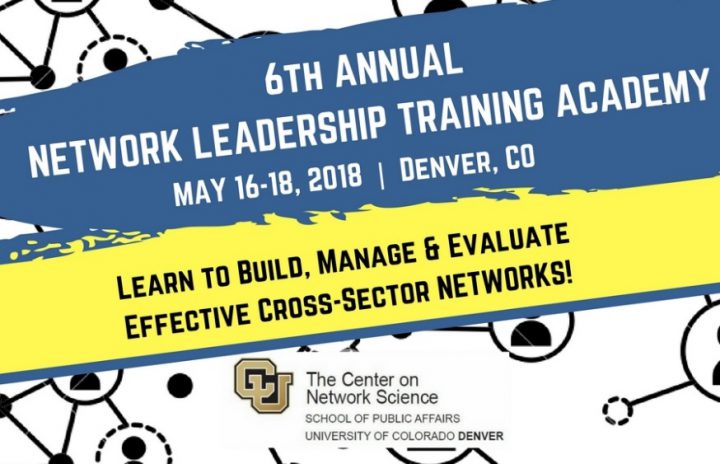
Last week I participated in the Network Leadership Training Academy hosted by the University of Colorado at Denver’s Center on Network Science. It was wonderful to meet fellow network geeks and enthusiasts from around the country and Canada and to hear about diverse applications of network theory and practice, from public health to public transportation, from early childhood education to after-school programming, from housing to firefighting.
I was invited to share some of what we at the Interaction Institute for Social Change are learning as we work at the intersection of networks and equity, which included telling the evolving story of Food Solutions New England. There seemed to be resonance with and appetite for going deeper to unpack how networks can be forces for truly equitable liberation from dysfunctional and damaging systems.
And there were many other presenters over the course of the couple of days I was able to attend. Here are some of my take-aways.
- In networks, less is often more with respect to personal connections. Given that people can only manage a certain number of social connections, a good question to ask is “How can we cultivate and maintain the fewest number of connections that are valuable?”
- Closed networks do not lend themselves to novelty. For innovation (and presumably for both resilience and adaptability) it is important to pay attention to “structural holes” in networks.
- Effective engagement rests on authentic listening, informal exchanges and meetings (lunch, coffee), identifying and honoring strengths and assets, thinking of people as people and not projects, constantly showing up and closing loops.
- In order to activate a network you have to have established sufficient trust and reciprocity.
- Effective networks for individual “leaders” are open (distributed), diverse and deep.
From conversation and reflection with participants:
- Connection is a social determinant of health.
- Increasingly healing needs to be viewed as a foundational goal of developing networks.
- Effective networks for individuals are not necessarily effective networks for collectives and social change. We have to be clear about what our scale and intentions are. (ON this front, check out this wonderful post by Christine Capra – “Networking Does Not Equal Network WEAVING“)
Additional resources to consult:
- The Partner Tool, a social network analysis tool designed to measure and monitor collaboration among people/organizations.
- Person-Centered Network App, for use by a provider to first screen a person to assess their gaps and strengths in their personal support systems and then, based on the results, link them to available community resources.
May 17, 2018
“Only connect! That was the whole of her sermon. Only connect the prose and the passion, and both will be exalted, and human love will be seen at its height. Live in fragments no longer.”
E.M. Forster, from Howard’s End
This is an excerpt from the final post in a series of five focused on networks for change in education and learning that have appeared on the Education Week and Next Generation Learning Challenges websites.
In this series on network design and network thinking, I explored the power and promise of networks as residing in how connection and flow contribute to life, liveliness and learning. See, especially, Connection is Fundamental.
In Why Linking Matters, I looked at how certain networks can more optimally create what are known as “network effects,” including small world reach, rapid dissemination, resilience, and adaptation.
I also noted, in Structure Matters in particular, that living systems–including classrooms, schools, school districts, and communities–are rooted in patterns of connection and flow. That’s why shifts in connections–between people, groups, and institutions–as well as flows of various kinds of resources can equate with systemic change, and ideally they can lead to greater health (in other words, equity, prosperity, sustainability).
Networks can also deliver myriad benefits to individual participants, including: inspiration; mutual support; learning and skill development; greater access to information, funding, and other resources; greater systemic or contextual awareness; breaking out of isolation and being a part of something larger; amplification of one’s voice and efforts; and new partnerships and joint projects.
It’s also true, however, that not every network or network activity creates all of these effects and outcomes. The last two posts looked at two factors that contribute to whether networks are able to deliver robust value to individual participants and the whole, including network structure and what form leadership takes. Networks are by no means a panacea to social and environmental issues and can easily replicate and exacerbate social inequities and environmentally extractive practice. So values certainly have a place, as does paying close attention to dynamics of power and privilege.
It is also the case that individual and collective behavior on a day-to-day basis have a lot to say about what networks are able to create. The following is a list of 25 behaviors for you to consider as part of your network practice as an educator:
- Weave connections and close triangles to create more intricacy in the network. Closing triangles means introducing people to one another, as opposed to networking for one’s own self, essentially a mesh or distributed structure rather than a hub-and-spoke structure.
- Create connections across boundaries/dimensions of difference. Invite and promote diversity in the network, which can contribute to resilience and innovation.
- Promote and pay attention to equity throughout the network. Equity here includes ensuring everyone has access to the resources and opportunities that can improve the quality of life and learning. Equity impact assessments are one helpful tool on this front.
- Name and work with power dynamics and unearned privilege in the direction of equity.
- Be aware of how implicit bias impacts your thinking and actions in the network. Become familiar with and practice de-biasing strategies.
- Think, learn, and work out loud, in the company of others or through virtual means. This contributes to the abundance of resources and learning in the network.
- Don’t hoard or be a bottleneck. Keep information and other resources flowing in the network.
- Identify and articulate your own needs and share them with others. Making requests can bring a network to life as people generally like to be helpful!
- Stay curious and ask questions; inquire of others to draw out common values, explicit and tacit knowledge, and other assets.
- Make ongoing generous offers to others, including services, information, connections.
For behaviors 11-25, see this link.
“… Keep reaching out, keep bringing in./This is how we are going to live for a long time: not always,/for every gardener knows that after the digging, after/the planting, after the long season of tending and growth, the harvest comes.”
Marge Piercy, from “The Seven of Pentacles”
May 14, 2018
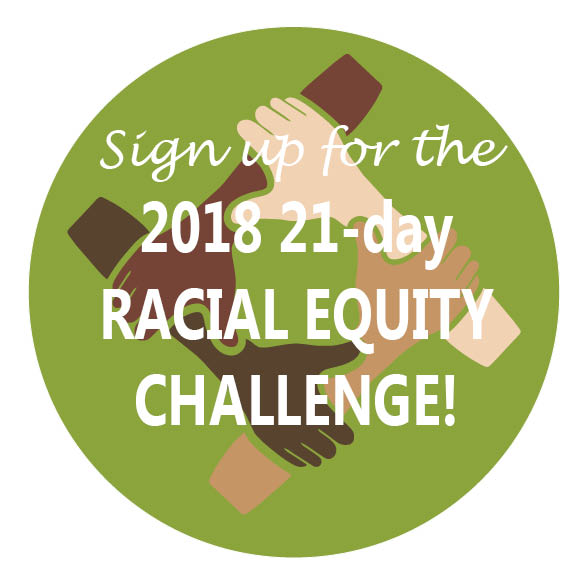 On April 22nd, the fourth annual 21 Day Racial Equity Habit Building Challenge wrapped up. This project with Food Solutions New England was originally conceived as a “network innovation” to spread and deepen the conversation about and commitment around addressing race and racism in food and related systems. This year the organizing team sought to go deeper, noting how much the national conversation has evolved in the past year. And we were heartened by the numbers (over 3,000 people from all 50 states and parts of Canada signed up) and by the quality of the conversation on-line and in different in-person venues where we met people who were participating. Certainly no one is under the illusion that the Challenge is enough, but we have heard that it is changing the way many see their work in food systems. Below you will find some of what was generously offered on-line in response to the daily email prompts and associated resources (readings, videos, audio clips).
On April 22nd, the fourth annual 21 Day Racial Equity Habit Building Challenge wrapped up. This project with Food Solutions New England was originally conceived as a “network innovation” to spread and deepen the conversation about and commitment around addressing race and racism in food and related systems. This year the organizing team sought to go deeper, noting how much the national conversation has evolved in the past year. And we were heartened by the numbers (over 3,000 people from all 50 states and parts of Canada signed up) and by the quality of the conversation on-line and in different in-person venues where we met people who were participating. Certainly no one is under the illusion that the Challenge is enough, but we have heard that it is changing the way many see their work in food systems. Below you will find some of what was generously offered on-line in response to the daily email prompts and associated resources (readings, videos, audio clips).
History of Race and Racism in the Food System: What is the history you hold in your head (and heart and body) about our current food systems?
“In my work at a non profit in the ‘good food’ movement, we constantly use language like ‘fix the broken food system.’ Reading these pieces on the historical underpinnings of racism in our food system illuminated for me just how much that statement (almost a throw away now) is situated within a racial caste system. To presume that ‘we’ must ‘fix’ a system ignores (by not naming) the racism present in that system. It lumps the goals of racial and food justice in with other, non-racialized issues (like soil health) also plaguing our current system, thereby continuing to perpetuate injustice through silence.”
“The consistent glorification of a food system, broken or fixed, imagined or real, that has systematically ignored the people that make it function, throughout the past and yet still in the present, is something I think I unknowingly participate in. Will naming this, calling it out, help us to change the structural racism that fuels this reality? How? I hope that by learning, studying, reflecting, and communicating that this group can indeed be somehow change-making, but it’s challenging to see a positive horizon when the change to be had is so large and primarily resides in legal, political and social institutions and structures. Forgive me for being still inside a state of feeling overwhelmed.”
The Colonization of Indigenous Land Rights and Food Ways: How does colonization continue to exist in our food systems and how can you support decolonization and celebrate indigenous rights and food ways?
“I just finished listening to The True History & Foods of Thanksgiving. My immediate reaction is shock and shame. I accepted Thanksgiving as an American celebration without ever wondering about its history. The podcast is a great conversation that educated me about how interwoven food, land, location, spirituality and culture are for some traditions within Native Americans. I wish we treated our lands and environment with the same care that many people were able to do before they were colonized.”
“In my state, treaties still continue to be broken with Native American communities, the most recent agreement being broken in 2015. State programs aimed to “help” are rooted in white supremacist ideologies. I think of Audrey Lorde when she declared, “For the master’s tools will never dismantle the master’s house. They may allow us to temporarily beat him at his own game, but they will never enable us to bring about genuine change. Racism and homophobia are real conditions of all our lives in this place and time. I urge each one of us here to reach down into that deep place of knowledge inside herself and touch that terror and loathing of any difference that lives here. See whose face it wears. Then the personal as the political can begin to illuminate all our choices.”
Read More
April 18, 2018
“Network entrepreneurs are keenly aware that they are few among many working across the larger system, and in this way they embody a special type of … leader[ship].

Image by tarotastic, shared under provisions of Creative Commons Attribution License 2.0.
This is the third in a series of blog posts that appear in their entirety on the Education Week website. In the previous post we considered how structure has implications for the extent to which a network or networked activity is able to leverage different kinds of net effects and create value for diverse participants. We also considered how structure has implications for both equity and how power is distributed. Another important consideration in how to create equitable benefit is what leadership looks like and how it plays out in and around networked activity.
The concept of leadership seems to be undergoing a rapid evolution lately. Especially in this “network age” there appears to be both a growing appreciation that leadership has always been about more than the singular and highly visible heroic individual, and that going forward, leadership must be upheld as much more of a shared and multi-dimensional endeavor.
“Leadership for this era is not a role or a set of traits; it is a zone of inter-relational process. Step in, step out.”
In much of the collaborative consulting work that we do through the Interaction Institute for Social Change, leadership (or what we at IISC often call Facilitative Leadership) is about “holding the whole.” That is, there is a need for groups, teams, organizations and communities to think more expansively about the state of a given complex system (community, economy, food system, organization, school, school district) and pay attention to what is required to support resiliency and/or change for more equitable and sustained benefit. In these situations, the traditional top-down images of leadership fall short.
In education, for example, we have seen hopes often pinned on seemingly superhuman teachers and principals who are brought in to “rescue failing kids and schools.” The assumption underlying such moves is that these extraordinary individuals will of their own drive and volition beat the odds and dramatically reverse the downward trajectory. This story may be the making of a box office smash, but in reality is met with mixed results at best. This is not to say that individuals cannot provide crucial sparks at important moments in organizations and communities. But holding out for heroic singular leadership ignores the systemic reality of what got us to where we are in the first place, and denies the more complex and connected response that is actually required.
“Leadership is helping to make the network smarter.”
Harold Jarche
Indications are that network leadership is at its best a dynamic, diverse, and multi-dimensional phenomenon. Many of those with whom IISC partners in the work of social and systems change understand this implicitly, and we have found it important to help them externalize and be more explicit about this by naming some of the roles that leadership can embody in a collaborative/networked world. Read More
April 4, 2018

The following is an excerpt from the third in a series of posts on networks, education and learning. The full post and series are published on the Education Week website. This post builds on two previous ones – Connection is Fundamental and Why Linking Matters – and looks at the importance of structure in supporting network effects while considering equity and power dynamics.
Networks are not necessarily easy to control in terms of their overall structure, especially when they are large and complex (diverse and widely distributed). And it is important to note that there are network phenomena that may tend to pull a networked endeavor in a certain structural direction.
For example, homophily is a phenomenon where social networks tend to form clusters of nodes with similar properties or attributes. This is captured by the adages, “Birds of a feather flock together,” and “Those close by form tight ties.” The result can be self-segregation along various lines of difference, for example racial, cultural, or class divisions in schools. Or consider the current pronounced political polarization in our country. The key to confronting homophily is to be both aware of the tendency and diligent about creating structures and incentives for bridging across boundaries.
“Opportunity … depends, at least in part, on our inherited networks.”
One of the great hopes and marvels of networks is that they can be liberating, especially in the face of bureaucracy and various barriers (see more about “network effects” in the previous post in this series). While this is worthy of celebration, another important phenomenon to be aware of is that networks can be deeply inequitable.
Read More
March 27, 2018
“We cannot live for ourselves alone. Our lives are connected by a thousand invisible threads, and along those sympathetic fibers, our actions run as causes and return to us as results.”
– Herman Melville
In an earlier post in this series on networks and education, we explored the underlying vitality of connection and flow in our world and how this can create opportunity and health in our lives and in learning. According to network theory and practice, it can make a big difference when we are aware of who is and is not connected and then act intentionally to build and leverage relationships in both number and quality. Stories from a variety of fields illustrate the phenomenon of small and great change being rooted in creating ties and flows between different actors and elements in a system.
Now let’s take a step back and ask, “What is a network?” A basic definition is that networks are nodes and links. That is, they are elements of different kinds (people, schools, other kinds of organizations) that are tied together (consciously or unconsciously) in some larger pattern by one or more types of connectedness–values, ideas, friends and acquaintances, likes, exchange, transportation routes, communications channels. Social networks, comprised of individual people or groups, can be experienced in person and also virtually.
In the world of education and learning, here are some of the ways networks show up:
- Open classrooms – Digital technology is used to connect students to a wide array of information and a diversity of community partners and real-world learning experiences both within and beyond a classroom’s walls. (e.g., CommunityShare)
- Communities of practice – Students, teachers, and school or district leaders connect their learning, engage in inquiry, and refine practice through learning webs within or across schools and districts.
- Community schools/schools robustly connected to local community ecosystem – Connections create opportunities for authentic learning, job readiness, and student resilience; wrap-around services ensure fuller suite of supports for students. (e.g., Dudley Street Neighborhood Initiative)
- Networks of schools – Schools are connected by their alignment to a model or philosophy, influencing a culture shift within the broader field of education.
- Movement networks/”networks of networks” – Collectives of schools or education organizations push for transformation in the field toward greater equity, democracy, “education as a public good” (e.g., National Public Education Support Fund).
- You (yes, you!) as a network (student, teacher, leader … all learners) – As individuals, we are (or can be) internally connected to multiple intelligences and ways of knowing–analytical/intellectual, embodied/somatic, emotional, spiritual.
The Value of Networks for Education and Learning
So what is the big deal about networks? Is there really anything new here? These are questions that come up, though seemingly less often over the past five years or so with the proliferation of various social media. On the one hand, networks have always existed as long as life has existed, so there is not anything new here. On the other hand, the various digital tools and technologies that have evolved to rapidly and dramatically shrink the world are showing us what more intricate and efficient forms of communication and exchange can make happen.
And while it is true that virtually all collaborative forms of social organization meet the basic definition of being a network (coalitions, alliances, organizations, communities), not all such forms leverage to the same extent what are called “network effects.” … To continue reading this post on the Education Week website, go to this link.
“You’ve got to keep asserting the complexity and the originality of life, and the multiplicity of it, and the facets of it.”
– Toni Morrison
March 10, 2018
“Relationship is the fundamental truth of this world of appearance.”
-Rabindranath Tagore
The following is a segment from the first post in a series focused on network theory and its actual and potential applications to education and learning. This series appears on the Education Week website and was invited by Next Generation Learning Challenges (NGLC) as it explores the potential of networks to advance equity, adaptability and excellence in public education …
Network theory is on the one hand a new and emerging interdisciplinary science and on the other hand it is ancient, grounded in indigenous and experiential ways of knowing about the reality of interconnectedness. Another important element of “network science” is imagination–the use of creative expression and metaphor that recognizes and works with relationship and relatedness that can help to guide our minds, hearts, and hands. These posts will draw insight from this broader understanding of network theory. This first post offers a larger view of the nature and potential of networks in our lives.
There is a lot of talk about networks these days. And there is considerable hope and effort being put into more interconnected ways of working and learning in order to bring about much needed innovation and change in multiple fields, including education. This is exciting, and at the same time I am concerned that the conversation can be relatively narrow, or leap ahead of some deeper insights of network theory and practice. In so doing there is a risk of not getting to the more promising potential of networks.
Connection is fundamental. This is a core observation of network theory (and various wisdom traditions). Network theory starts by pointing to the fact that we often talk about the world in terms of individual things and their properties. This kind of approach may work in situations and in systems that are fairly simple and relatively static. But when the interactions and the complexity of the elements in a system increase, it is the connections that determine the characteristics of the elements in the system and its overall health. This holds true for any kind of dynamic living system–ecosystems, human communities, economies, etc.
“Network theory suggests that what a system becomes emerges from the complex, responsive relationships of its members, continuously developing in communication.”
-Esko Kilpi
Life is at base a network. It thrives on connection. We all know this, experientially, because we are alive! And when we are not feeling alive or lively it is often because we are disconnected, cut off in some way–from other people, from the natural world, from our selves (feelings, bodies, values), from power or a sense of purpose. (See the UK’s recent move, incidentally, to appoint a Minister of Loneliness to address the multiple ills stemming from growing social isolation). Life thrives on connection. …
To continue reading this post, follow this link.
February 19, 2018
“It’s not knowing what to do that counts, it’s knowing what to do when you don’t know what to do.”

Last week I had the privilege of co-leading a three day Facilitative Leadership for Social Change training for a group of health equity advocates in Springfield, Massachusetts. It had been a while since I had done a training of that length, and it was a nice opportunity to not only cover more material, but to deepen the conversation and practice. Along the way there were many good questions about what to do around various challenges when one is co-leading a collaborative change effort. And a common response was, “It depends.”
Every group is different, every circumstance is different, and while it might make sense to take some cues from what has been successful in other situations, the caution is not to assume that it will work, or work in the same way, in other situations. This is one reason that I personally do not like the phrase “best practice” when talking about collaborative and facilitative change work. Given the complexity of people and social systems, I find it more helpful to think about “promising practices.”
That said, a promising practice that came up time and time again in our three day training, was the practice or practicing, of ongoing devotion to muscle-building in leadership skills such as process design, facilitation, coaching (leading with listening and inquiry), systems thinking, visioning/imagining, mutual learning and collaborative decision-making/governance. And in undertaking such practice, we at IISC would suggest this is not about achieving perfection. The humbling and exciting thing about collaborative leadership, in my humble opinion, is that it is a life-long learning pursuit and an endless opportunity to deepen understanding of ourselves, others and living systems. For this reason, one of my mantras is:
Practice for presence, not for perfection.
That is, practice can help practitioners get beyond being caught up in simply “learning the scales” of collaborative leadership, in trying to get the skills “right.” Practice at its best can contribute to a state of being more fully present to what is happening in any given situation and being able to work with that in powerfully improvisational ways.
Furthermore, over the past year, there has been a clear call for practice and practices that are explicitly about cultivating spaces to hold difference and tension and trauma. That may be another order of presence characterized by a deeper tuning in and movement away from more transactional processes to ones that are emergent, co-created and geared towards supporting moral courage and imagination. What that can require is vulnerability and a humble sense of “being with.” What it stands to make possible, as opposed to business-as-usual, is growth and real movement forward, together.
January 24, 2018
“The most robust and resilient networks are those that create additional value for each participant while strengthening a community or ecosystem as a whole.”

Return-on-investment (ROI) is not a term that I love, especially given how militantly utilitarian and narrowly it is often considered and applied. My friend, mentor, business consultant and holistic thinker Carol Sanford refers to ROI as “the future increase in value that is expected when the initial capital contribution is made.” Carol is quick to point out that capital can take many forms (financial, intellectual, social, spiritual, natural, etc.), and for network participants (or let’s call them “co-creators”) this often takes the form of investments of time, money, knowledge, creativity, and social connections.
Why would co-creators in networks take the time and risk to make such an investment? What is the expected return? Presumably, when we are talking about networks for social change, the principle driver is the desire to make a meaningful difference for people, places and purposes they care about and that they sense will be more positively impacted through network activity. Co-creators are also “kept in the network game” if participation enhances their own capabilities, grows and deepens their connections, and gives them increased opportunities to be creative, and perhaps even find a place of belonging! Read More





 On April 22nd, the fourth annual
On April 22nd, the fourth annual 

